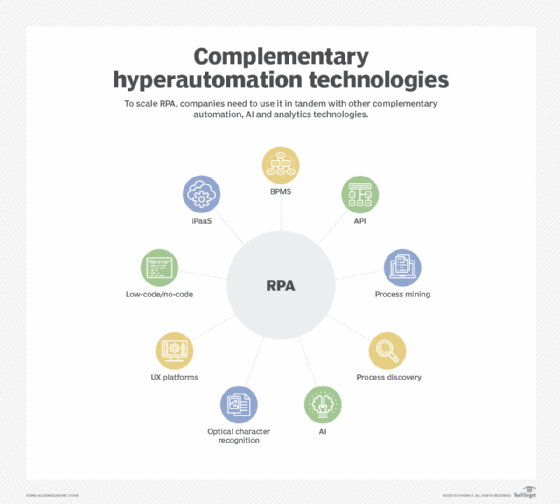What CIOs need to know about the future of hyperautomation
Appian founder and CEO Matt Calkins dives into the benefits of hyperautomation and how unifying technologies will ultimately help enterprises achieve success in today's digital age.
While most business leaders are adopting emerging technologies as part of their digital transformation initiatives, they may not yet be aware of the future of hyperautomation -- a trend that is bound to make a significant impact in the enterprise.
Matt Calkins, founder and CEO of the software company Appian, said he thinks hyperautomation -- taking automation and scaling it up at the enterprise level by unifying technologies like robotic process automation (RPA), AI and machine learning -- is set to deliver huge benefits to businesses.
But why hyperautomation, and why now?
Hyperautomation is automation at speed and is composed of technologies that can enable faster application authorship and coordinate different worker types, Calkins said in the introduction of his new book titled HYPERAUTOMATION.
"Both are essential in the new decade. Businesses will want to deploy workers more efficiently, and they will want to invent new work patterns faster," he added. "The world has changed. Tomorrow's enterprise will need agility, unification, speed, and collaboration. In a word, it will need hyperautomation."
The book, which was released by Appian in October 2020 and includes a foreword by chess grandmaster Garry Kasparov, is a curated collection of essays from industry experts that offer an array of opinions and perspectives. Readers will learn many aspects of automation with topics ranging from the evolution and the benefits of low-code platforms and business process automation to the ways in which leaders can master digital innovation within their organizations.
What follows is a Q&A with Calkins. Readers can purchase HYPERAUTOMATION here. All proceeds of the book are donated to Black Girls Code, an organization that provides young girls of color the opportunity to learn and master technology skills and computer programming.
Can you briefly describe what hyperautomation is -- specifically, the technologies enabling it and its key components?
Matt Calkins: On an absolute microcosm level, automation means bringing together different kinds of workers in a workflow. These days, people do work, AI does work [and] RPA does work, and we need to bring it all together -- merging, collaborating, handing off work and delegating and coordinating. That's automation, and that alone is kind of a thrill. Different workers have different strengths and together are stronger. When you think big [and] about where that trend is going, you realize that we are surrounded by dispersed assets. It isn't just that there's different kinds of workers -- there's workers in different places like you and me, there's data in different places [and] our customers are even in a different place from our business. We've never been more dispersed in the history of business, and so that technology that is good at stitching together types of workers is also good at stitching together this entire decentralized universe that we find ourselves in and coordinating, again, those dispersed elements.
Hyperautomation takes that core idea that a workflow can bring together different kinds of workers in coordination and says, 'Hey, we can do more than that. We can bring together data workers, human customers, [and] we can stitch together our disunified enterprise in the same way as we united workers.'

Why do you believe there is a future of hyperautomation? Do you think it would've had the same momentum if not for the COVID-19 pandemic?
Calkins: It may not have been the pandemic specifically, but the fact that a major change happened, I believe that any serious rethink would have concluded the following. We have many assets -- data, worker types, employees and customers -- but they're just so dispersed [and] disunified. That's not what people want. Our customers want the human experience, [and] employees want to express their human side instead of behaving in a scripted manner, and somehow, we're not getting it. We need a technology to stitch our enterprise back together and allow us to do the things that we're best at.
I feel any big rethink would have landed at that conclusion. The pandemic was uniquely so because it dispersed us even more.
An ongoing concern for employees in the enterprise is job security and whether automation will ultimately result in job losses. However, in the book, you mention that automation in an earlier era meant replacing people with technology but that it's now, in fact, a uniting technology. What changed?
Calkins: I think it will result in there being as many jobs as there are people, to be precise -- we want to free people up to do more important things. Technology is not used to cut the workforce -- it is used to empower and strengthen and make the workforce create more value. Automation is supposed to free people up to do human work.
In her essay, Lisa Heneghan mentions the significance of cultural change in digital transformation, George Westerman states that technology changes quickly but organizations change much more slowly, and Lakshmi N. explains situations where too many people in a large company don't understand the technology. Why do you think innovative leadership is so important, and what does it have to do with hyperautomation?
Calkins: Lisa Heneghan is right. It's true that there's a cultural shift here [and] not just a technology shift. And the cultural shift is about putting people first, empowering [them so they're] no longer victims of the enterprise of software that surrounds them. Now, they're in charge and in control -- that's the essential shift. You realize software doesn't have to hold [you] back in the past any longer -- it never should have -- and now [it] can lead the way.
When you think of a new behavior for your organization, you could instantiate that in software first and then tell everybody, 'Hey, this is why we're doing it. We want to be more customer-centric.' The idea now is that software, which is ephemeral, should be the first thing [to] change when you want to move your business to a new identity. This is a kind of human-centric concept -- even though it's about software, it's about saying what you think you can be and then do it. In the past, it might have been, 'I can imagine it, but there's no way I can make this happen. I [have] 100 different systems, [and] I can't even connect them, never mind change them. This is empowerment -- this is saying that which you can imagine, now you can do.






